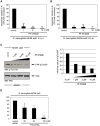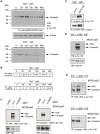Cell invasion by Neisseria meningitidis requires a functional interplay between the focal adhesion kinase, Src and cortactin
- PMID: 22768099
- PMCID: PMC3387252
- DOI: 10.1371/journal.pone.0039613
Cell invasion by Neisseria meningitidis requires a functional interplay between the focal adhesion kinase, Src and cortactin
Abstract
Entry of Neisseria meningitidis (the meningococcus) into human brain microvascular endothelial cells (HBMEC) is mediated by fibronectin or vitronectin bound to the surface protein Opc forming a bridge to the respective integrins. This interaction leads to cytoskeletal rearrangement and uptake of meningococci. In this study, we determined that the focal adhesion kinase (FAK), which directly associates with integrins, is involved in integrin-mediated internalization of N. meningitidis in HBMEC. Inhibition of FAK activity by the specific FAK inhibitor PF 573882 reduced Opc-mediated invasion of HBMEC more than 90%. Moreover, overexpression of FAK mutants that were either impaired in the kinase activity or were not capable of autophosphorylation or overexpression of the dominant-negative version of FAK (FRNK) blocked integrin-mediated internalization of N. meningitidis. Importantly, FAK-deficient fibroblasts were significantly less invaded by N. meningitidis. Furthermore, N. meningitidis induced tyrosine phosphorylation of several host proteins including the FAK/Src complex substrate cortactin. Inhibition of cortactin expression by siRNA silencing and mutation of critical amino acid residues within cortactin, that encompass Arp2/3 association and dynamin binding, significantly reduced meningococcal invasion into eukaryotic cells suggesting that both domains are critical for efficient uptake of N. meningitidis into eukaryotic cells. Together, these results indicate that N. meningitidis exploits the integrin signal pathway for its entry and that FAK mediates the transfer of signals from activated integrins to the cytoskeleton. A cooperative interplay between FAK, Src and cortactin then enables endocytosis of N. meningitidis into host cells.
Conflict of interest statement
Figures







Similar articles
-
Entry of Neisseria meningitidis into mammalian cells requires the Src family protein tyrosine kinases.Infect Immun. 2010 May;78(5):1905-14. doi: 10.1128/IAI.01267-09. Epub 2010 Feb 22. Infect Immun. 2010. PMID: 20176789 Free PMC article.
-
Cellular invasion by Staphylococcus aureus reveals a functional link between focal adhesion kinase and cortactin in integrin-mediated internalisation.J Cell Sci. 2005 May 15;118(Pt 10):2189-200. doi: 10.1242/jcs.02328. Epub 2005 Apr 26. J Cell Sci. 2005. PMID: 15855238
-
Tyrosine phosphorylation of cortactin by the FAK-Src complex at focal adhesions regulates cell motility.BMC Cell Biol. 2011 Nov 13;12:49. doi: 10.1186/1471-2121-12-49. BMC Cell Biol. 2011. PMID: 22078467 Free PMC article.
-
Role of focal adhesion kinase in integrin signaling.Int J Biochem Cell Biol. 1997 Aug-Sep;29(8-9):1085-96. doi: 10.1016/s1357-2725(97)00051-4. Int J Biochem Cell Biol. 1997. PMID: 9416004 Review.
-
Cortactin: A universal host cytoskeletal target of Gram-negative and Gram-positive bacterial pathogens.Mol Microbiol. 2022 Dec;118(6):623-636. doi: 10.1111/mmi.15002. Epub 2022 Dec 4. Mol Microbiol. 2022. PMID: 36396951 Review.
Cited by
-
Junctional proteins of the blood-brain barrier: New insights into function and dysfunction.Tissue Barriers. 2016 Feb 26;4(1):e1154641. doi: 10.1080/21688370.2016.1154641. eCollection 2016 Jan-Mar. Tissue Barriers. 2016. PMID: 27141427 Free PMC article. Review.
-
Neisseriae internalization by epithelial cells is enhanced by TLR2 stimulation.Microbes Infect. 2016 Oct;18(10):627-638. doi: 10.1016/j.micinf.2016.06.001. Epub 2016 Jul 1. Microbes Infect. 2016. PMID: 27373686 Free PMC article.
-
Role of epidermal growth factor receptor signaling in the interaction of Neisseria meningitidis with endothelial cells.Infect Immun. 2014 Mar;82(3):1243-55. doi: 10.1128/IAI.01346-13. Epub 2013 Dec 30. Infect Immun. 2014. PMID: 24379285 Free PMC article.
-
Serine phosphorylation of cortactin is required for maximal host cell invasion by Campylobacter jejuni.Cell Commun Signal. 2013 Nov 4;11:82. doi: 10.1186/1478-811X-11-82. Cell Commun Signal. 2013. PMID: 24188565 Free PMC article.
-
Cortactin Mediates Apoptosis of Gastric Epithelial Cells Induced by VacA Protein of Helicobacter pylori.Dig Dis Sci. 2016 Jan;61(1):80-90. doi: 10.1007/s10620-015-3836-0. Epub 2015 Aug 20. Dig Dis Sci. 2016. PMID: 26289258
References
-
- Scarselli M, Serruto D, Montanari P, Capecchi B, Adu-Bobie J, et al. Neisseria meningitidis NhhA is a multifunctional trimeric autotransporter adhesin. Mol Microbiol. 2006;61:631–644. - PubMed
-
- Virji M. Pathogenic neisseriae: surface modulation, pathogenesis and infection control. Nat Rev Microbiol. 2009;7:274–286. - PubMed
Publication types
MeSH terms
Substances
LinkOut - more resources
Full Text Sources
Miscellaneous

